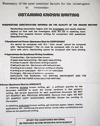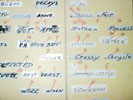
|
True handwriting analysis involves careful examination of the design, shape and structure of handwriting to determine who wrote it. The basic principle of handwriting analysis is that no two people write something exactly the same way.
Handwriting analysis looks at letter formations, connecting strokes between the letters, upstrokes, retraces, downstrokes, spacing, baseline, curves, size, distortions, hesitations and a number of other characteristics of handwriting. By examining these details and variations in a possible piece of evidence and comparing them to a sample of known authorship, forensic scientists can say whether or not the samples were written by the same person. Handwriting analysis is useful in a range of circumstances. These include:
1. Sign your name on a blank piece of paper as you would sign a receipt or some other document. Have several friends do the same. Swap papers. Take a few minutes and try to forge each other's signatures. 2. Even more difficult, collect some writing samples from a classmate and try to forge a paragraph of their writing. Share the paragraph and the original writing samples. Can anyone tell that the paragraph is a forgery?
Obtaining known writing Summary of the most essential factors. This document hangs on the wall of a police handwriting office. It is very well worn and lists the Dos and Don'ts of obtaining a known handwriting specimen. It's worth examining!
Compare handwriting samples Examine a chart. This document is a part of a handwriting comparison chart produced for display in court. The left side of the photo contains cut-out letters from a forged document. The right hand side shows matching elements taken from a letter known to have been written by the suspect. Take careful note of the small numbers which indicate the matching elements. ForgeryIt is actually possible to commit a crime by forging your own signature! Forgery is the creation of falsified material or the altering of any writing with the purpose of defrauding or cheating. There are four basic types of forgery: traced, simulation, freehand and lifted. Tracing
Simulation
Freehand
Lifted forgery
Traced forgeries and lifts are easy enough to detect but the identity of the forger cannot be easily determined.
|







